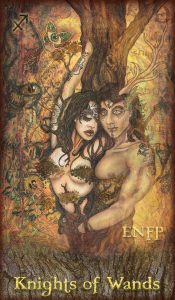
Knights of Wands
I was doing an exercise where you pick tarot cards that represent different things for you.
I got stuck on the first one, the significator. I just couldn’t pick one that suited what I thought the card should represent. So, I decided to make one…
This is my version of the Knight of Wands.
To begin with, this card is called the Knights of Wands as it features two figures, one male, one female. In this case, Dionysus and ‘The Faerie Queen’.
I chose to do this because the court cards depict personality types and character traits for people who are like the correspondences of the card. The person viewing the card may not wish to see the stereotypical male knight that we are usually presented with.
You can view this card as being both masculine and feminine, either as separate entities, as concepts of similarity (a mental state or personality traits) or as two halves of the same being (androgyne) as both are connected at the root by a single tree.
My main idea behind this is that no matter how you define your gender, you as a person have both feminine and masculine aspects of yourself. Art symbology uses this as a device to depict different aspects of yourself. Mentally, philosophically or spiritually, these ideas in art are represented by their feminine and masculine identifiers, symbolically and historically.
Joseph Campbell talks about the male/female principle as coming to symbolize the union of opposites within the individual psyche in one of his versions of the story of Teiresias . In his lecture he states that one must truly know both aspects of themselves to ‘know thyself.’
Dr. Carl Jung dubbed these feminine and masculine archetypes anima and animus.
The Chinese call these polar halves Yin and Yang.
Let’s now explore the anima and animus of the Knight of Wands.
The symbols most commonly identified with this card are fire and the astrological sign Sagittarius.
Fire = the Will
Sagittarius = the searcher, dreamer, head in the clouds, loyal, blunt, philosophical and also a fire sign
This is Fire of Fire, double the will, double the enthusiasm… double the trouble!
In my opinion, I agree with the belief that the MBTI ( Myers-Briggs personality type) that matches this card is ENFP
Extrovert, Intuitive, Feeling, Perceiving.
Nearly 30-40% of sites/books also suggest ESFP as matching, the s= sensing.
However, I feel this suits the Knight of Cups, which I will explain…
The difference between the ENFP and ESFP is that the ENFP relates to the world and others philosophically, experiencing life through the wonders of the world and their point of view and ideas about it. The ESFP experiences the world and others by experiencing life and analysing those experiences. The two personalities are very much the same except for this one major difference in analytical thought, which changes the way they interact with situations.
Here are some examples:
ESFP: will get to know others by swapping stories about their past to find similarities and connection
ENFP: will get to know others by swapping ideas and perceptions on life and whether you share those ideals or can relate to them
ESFP: will stop a conversation to point out an observation they have just seen
ENFP: will converse on topic, drift off, lose track of time and are completely unaware of anything in their surroundings.
ESFP: wants to be recognized for their accomplishments, what they are doing in life.
ENFP: wants to be recognized for their thoughts and ideas, what they are thinking about in life.
ESFP: competent at maintaining a wide circle of friends and have a core inner circle whom they spend the most of their time with.
ENFP: struggle to maintain a wide circle of friends. They like the company of new people, but rarely feel understood for who they truly are by anyone other than a select core group of people or person.
ESFP: may be quick to adapt themselves to others’ way of thinking or doing things in order to avoid conflict.
ENFP: are stubborn to a fault and would usually rather terminate a relationship than neglect a crucial part of their identity for the sake of harmony.
ESFP: Passive emotional feeling
ENFP: Aggressive active feeling
The Knight of Wands is Fire of Fire, nothing passive about this card : ENFP.
It was very hard to choose a character to fit the personality because when researching this field of thought, everyone disagrees!
I think this is mainly because you have multiple ways of looking at a character and a personality based on how you view their character traits (positively or negatively) and this will funnily enough be down to your own personality types. What a giant circle this will create, a dog chasing its own tail.
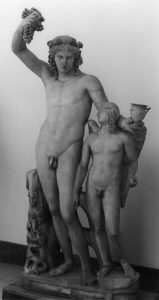
Dionysus and Eros, Naples Archeological Museum.
Date March 1999
For the male representative, I decided to go with Dionysus with ENFP for both his darker aspects and his personality.
Again, as a contender for both ENFP and ESFP, the competition was overwhelming.
Dionysus is the half-brother of Apollo and younger brother of Hermes. Apollo is the other huge contender for ENFP, as he is a creative and active fire god. But he is more emotionally bound, making him more Fire of Water. Having said this, this is also a reason used for Dionysus as he was born of heat and nurtured by water, like the grape, which is a symbol of the god in the Orphic tradition.
Dionysus is the god of wine and ecstatic cult experience. Eagerly and actively experimental with sensual/sexual experiences, he would spend his time drinking with Satyrs like Pan and having relations with the Nymphs.
This person is very experimental, he loves to try things, sometimes in excess. He will display this in outward expression of the self, personality and sexuality. This person will be the snake in the garden or find that they are filled with a need to explore their sexuality and personal expression through many means.
Dionysus and Demeter were the supreme deities of the earth. Later he would become linked with Bacchus and Cernunnos; the pagan god of the hunt, the male active participant in sacred sexual union celebrated at Beltane. He rebelled against social norms, much like those who follow the left- hand path and became a patron for all kinds who reject traditionalism. Dionysus turned his lifestyle into a religion and gained many followers who gave him constant validation and admiration for the spiritual excitement and reverence they would experience.
As you can guess, like Dionysus, this person will be the life of a party, or at least fairly entertaining at one.
Dionysus was a god known for his light heartedness and always offered his assistance to anyone who asked. This made him very popular with the gods and people alike. Nevertheless, Dionysus was at times misunderstood, which could lead to drastic repercussions (the gory execution of Pentheus, by convincing his mother and other women to go mad and tear him from limb to limb with their bare hands.)
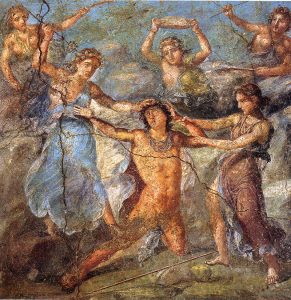
Pentheus being torn by maenads. Roman fresco from
the northern wall of the triclinium in the Casa dei Vettii (VI 15,1) in Pompeii.
He was one of the twelve Olympians, although he did not actually live in Olympus, and his unusual birth and upbringing made him outsider. He was often called Eleutherios, “the liberator,” because his wine, music, and ecstatic dance liberated his followers from insecurities, inhibitions and the restraints of society. Because of this he was often seen as one who crossed between worlds especially between the civilized and uncivilized, the known and unknown, the mortal and immortal.
This is not surprising as he was the only god to have a mortal mother, so there are always two sides for the twice born son. He was sometimes seen as the god of chaos and the protector of the outsider and underdogs.
As he was also a god connected to harvest (grapes), he was always joyful and content during spring and summer but miserable and discontent during autumn and winter. Giving him a manic-depressive type personality. When this person gets enthusiastic, they are obsessed, all out. However, they can go polar opposite at the flick of a switch or change of heart.
Dionysus had a similar life experience to Jesus; he wandered the earth in his early adult life, teaching men the culture of the vine (that would have been a more popular message to pour down the throat 😉.) Dionysus was the main religious focus for unrestrained consumption. Once he has a cause he will push it around the world to any ear that will hear it. As a person, this type will find their thing – material or mental – and consume until there is no tomorrow. Quite the addictive personality.
Dionysus teaches us to embrace the negative parts of ourselves. Be a friend to your dark half, embrace your faults and overcome yourself. What doesn’t kill you makes you stronger, especially if it feels good! Use your shadow and become an artist and artisan!
He is a tempting force, a convincer. Dionysus is the god of ritual madness.
He is known as someone who can be kind but cruel when he feels it necessary.
So as there are two sides to Dionysus, there is a dark destructive side to this personality and a healthy positive side.
The destructive ENFP is manipulative, self-absorbed, and disloyal. They believe the world rotates around them, the gods of their own universe and their interests and ideas. They only care about others in terms of how much they can get out of them, like Nietzsche’s theory of mutual use.
They jump from one idea or relationship to the next like the rapid spreading of fire, flaking on plans and ignoring responsibilities. Inspiration and stimulation IS everything to the unhealthy ENFP, and they will try to attain it by any means, even if it means deceit or crossing the line between the moral or immoral. They are so sure of their own visions that they attack anyone who opposes them or questions their abilities. They forget their own body’s requirements and may become increasingly self-destructive as they ignore their health and nutritional needs. As in this image the fire grows so big that eventually it will set fire to the tree they are made of and consume them entirely.
The healthy ENFP is empathetic, imaginative, and innovative. They enjoy inspiring people and showing them all the amazing possibilities the world can provide. They are responsible with their relationships and selfless in their concern for others. They enjoy sticking up for people who are hurting, and they want to find innovative ways to improve the future for the next generation. They are friendly, open-minded, and enthusiastic.
the Fairy Woods by Henry Meynell Rheam, 1903, public domain[/caption]
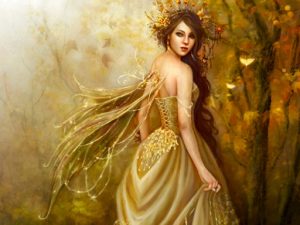
The Fairy Queen. J. N. Paton.
For the female representation I decided to go with the Faerie/Pixie.
Queen of Fae/Pixie
Again to find a concrete contender was very difficult as original tales of faerie queens had no names, they were just named ‘Faerie Queen.’ Pixies are assimilated with faeries and later with witches, and both are linked early on with banshees, usually depending on what their temperament was.
For example:
benevolent – fae,
troublesome/playful – pixie/fae
troublesome and nasty – pixie/sprite/witch
frightening and evil or bringer of death – Fae/witch/banshee
I decided as most of the similarities between ENFP personalities tended towards just pixie and faerie traits I would include them both, embodied in one image of a pixie/faerie Queen.
Faeries and pixies are magical and inspiring. They are child-like with wonder and innocence, creative and inhibited, light hearted and playful. Sweet and full of love and they can fly!
However they are also very guarded and private, you really need to earn their trust before they’ll even consider letting you into their world. If they are sad or their joy is squashed, it can ultimately destroy them entirely. They are totally ruled by their feelings.
The two Fae Queens I thought of as good contenders were Aoibheall and Áine; some believe they may be one and the same. Like other deities these two are associated with other famous deities like Mab and the Morrigan.
Aoibheall, pronounced ‘Eeval’ (not evil), is also associated with fire. Like the flame itself, she is beautiful and warm, yet dangerous and can be either terribly destructive or a wonderful presence. She is known to interfere in human lives and issues for both benevolent and malignant reasons.
In folklore, some stories say she has control over the weather and she owns a magical harp whose music kills those who hear it. This may be why she is considered to be an omen of death in some stories. Volatile in mood and as unpredictable as any of the fae, Aoibheall is also both more openly blissful and quick to anger.
She has an affection for poets and musicians, although can be a bit tough towards men.
Aoibheall is a complex folkloric figure. Her actions in poem and song seem benevolent, yet in folklore she is associated with death, both through its prediction and causing it with her harp music. Like many Fairy Queens she takes human lovers, easily acquired to quench her desires and curiosities. Ultimately, she is as much mystery as certainty. She was sometimes known as the Faerie Queen of Love. Although in some stories this could be pleasure or a curse. On the story of one of her loves Dubhlaing uí Artigan for example, at one point she was trying to save him from death and then in the later cursing him with death. Not good from a queen who has the power to predict or give death sentences with a simple pluck of her harp.
Aoibeheall also had a magical court, in one case she passed judgement on the husbands of Ireland as to whether they were satisfying their wives. Should a husband be found wanting he was ordered by the midnight court to fulfil his manly duties or be plagued by fairies. It seems a treatment especially derived for older males who took younger wives.
Aine and Aoibeheall are linked by some due to their uncanny similarity in the role of banshee and the customs surrounding that role, for their designated families.
Áine’s name has a variety of meanings including brightness, splendor, radiance, flame, and swiftness, and she is associated with midsummer and the sun or fire. Aine is considered a goddess of love and fertility, giving her command over crops and animals. She is also associated with agriculture like Demeter (linked with Dionysus). As a fairy Queen it was believed that she could bring blessing and prosperity to people, but her roots as a goddess also gave her sway over sovereignty and we see her both legitimizing kings and destroying kings in her stories. Fair enough too as these kings seem to have a tendency for rape. It’s no wonder she exacts revenge on them. This is important, as the Celtic men went off to war to protect their lands the woman had to stay behind and become the protector of the home. Unfortunately, the cruelty that men bestow upon women was a day-to-day reality for these womenfolk, thus they found kinship with their Faerie Queen, Aine, who suffered the same.
She loved riding under a full moon with her sisters, joyfully and wildly. It is possible she represented the waxing and waning parts of the solar year.
Aine is a muse to every poet. She could inspire great works of creativity or drive the artist to madness… a little like Dionysus.
She was the people’s Goddess; she gave much to them and received their love and worship in return. Again, like Dionysus. An ancient myth tells of how Aine gave the gift of grain to Ireland. Aine sat in her birthing chair on Lammas, August 1st, and gave birth to a sheave of grain. So, the first Friday, Saturday, and Sunday after Lammas are also her sacred days.
Aine’s popularity was helped by her role as Goddess of Love. Like most of the Fae Queens she did indulge in many mortal male lovers. Aine, in particular, is known for teaching her mortals about love, both by taking human men as lovers and by teaching humans how to express their love in a sacred manner. She had many children through her love of mortal men, birthing what some believe to be a magical Faerie/Human race. There is one account of her son (a magician) possibly being Merlin himself.
Aine is known as a Queen with the power of intelligence, ingenuity and determination. A wise and ambiguous otherworldly figure, while other stories paint her as devious and dangerous.
The truth is, to try and determine a Faery’s personality is almost impossible, as their fiery nature and temperament changes so surprisingly… apparently like that of the ENFP.
These people are known to be playful and cheeky like the pixie or child-sized fae They are known to be sexual and have great love for one or many, like the human-sized fae; this love knowing no bounds. However, at the same time, they can turn like the fire in the wind, like the dangerous faerie kings and queens who can reign down scorn and judgment or just cut you out by making the bridge to their world disappear completely.
(Kate Winslet in Eternal Sunshine of the Spotless Mind)
In this image, The Faerie Queen is sensual but almost sad. I would like to talk about a fictional terminology that is used to describe a character. This is character is known as the ‘Manic-pixie-dream-girl.’
This is a derogative term or stereotype which defines a character, one who you could say has the personality type of specifically female ENFPs, and is usually a female lead in films or books. With this term, they turn the ENFP woman into an object that is perfect for a man to fall in love with… temporarily, to “discover their own sexuality” but due to the manic nature of the female, upon maturity the male will often cast them aside as the relationship was doomed to fail or the girl will leave, incapable of having one fixed relationship.
Nathan Rabin says, “that bubbly, shallow cinematic creature that exists solely in the fevered imaginations of sensitive writer-directors to teach broodingly soulful young men to embrace life and its infinite mysteries and adventures.” A pretty, outgoing, whacky female romantic lead whose sole purpose is to help broody male characters lighten up and enjoy their lives. This is a bit unfair. They are seen as being practically useless in the outside world, if it wasn’t for their boring counterpart bringing them back down to earth again.
This is a clear case of other personalities misunderstanding the complex dual nature of the ENFP.
Unfortunately it is a part of the package that when you feel and experience something so strongly the pendulum will swing both ways. A good lover would recognize this and find coping mechanisms for their partner instead of allowing the relationship to crumble or be discarded.
It’s not easy being fae, ask one!
Unfortunately for this personality the playful and experimental, sexual, creative, expressive nature leads others to believe that their heads are always in the clouds, immature and disconnected from reality and when they are living in the real world, they are apparently too miserable to be around.
So much fun until they need emotional support in return. Would it not be surprising that after the constant giving to boring guy that they may feel a bit drained?
This personality is very playful, fun and thoughtful. But they can be led astray, down a wrong path, through what seem like great ideas at the time. But even upon realizing, through stubbornness they may continue down this path instead of quitting.
Let’s move on.
As a knight:
This person is ready to charge into anything if it’s exciting or going to feel good.
They will be persistent. This person is goal orientated and will stop at nothing to achieve their dreams.
They live an active social lifestyle and participate in anything that will broaden their thought or ideas.
As the fox:
This person is witty, quick to respond, cunning, a bit of a trickster, clever but will not let this stop them from care-free frolicking in long grass – even if there are hunters about.
As a lizard:
Chameleon like and everchanging; they can be hot and cold. They cling to their convictions like a rock, observe everything and develop ideas on how this relates to the world. They are very adaptable and can mold to most situations.
The butterflies:
Represent the metamorphosis between the aggression and empathetic nature of this character, easily giving but easily hurt. Can be open or closed. This personality has a myriad of contradictions or dual nature characteristics.
As the single tree:
As mentioned before, this can be interpreted as being a single person. the ENFP can have a tendency to put the wants of themselves before all others. Their passion being the end all. This can also represent the duel nature of this personality. Sensual or user, involved/uninvolved, logical yet sporadic, sensible but irrational. It can also be symbolic of being cut from the same ilk.
The Knights of Wands like to have the illusion of freedom, to do as they wish like a faerie with unlimited powers but innocent enough to not destroy the world with them. They like to live for today, in excess if possible (like Dionysus) but reward others with wisdom and gifts for their company and devotion. Treat them well and they will give back tenfold. Treat them poorly, more fool you.
They are what happens when you discover fire: wonder, beauty, curiosity, experimentation and sometimes pain, but always worth the experience. They never fail to burn their mark on your mind or heart forever.
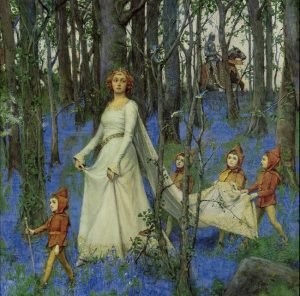
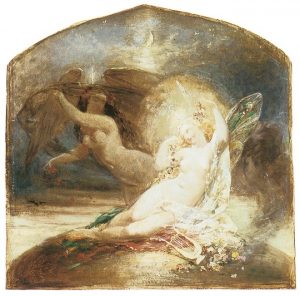

Leave a Reply